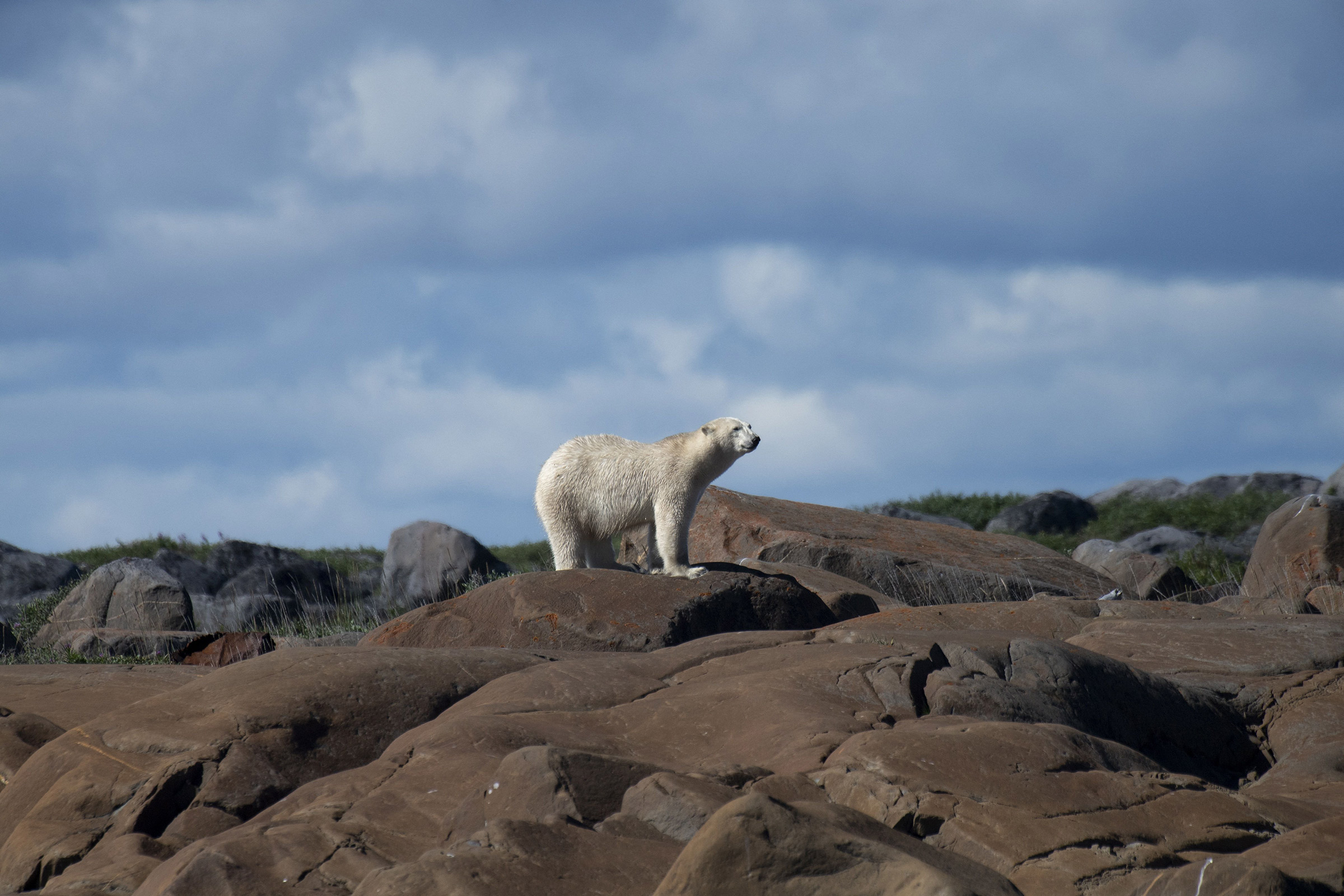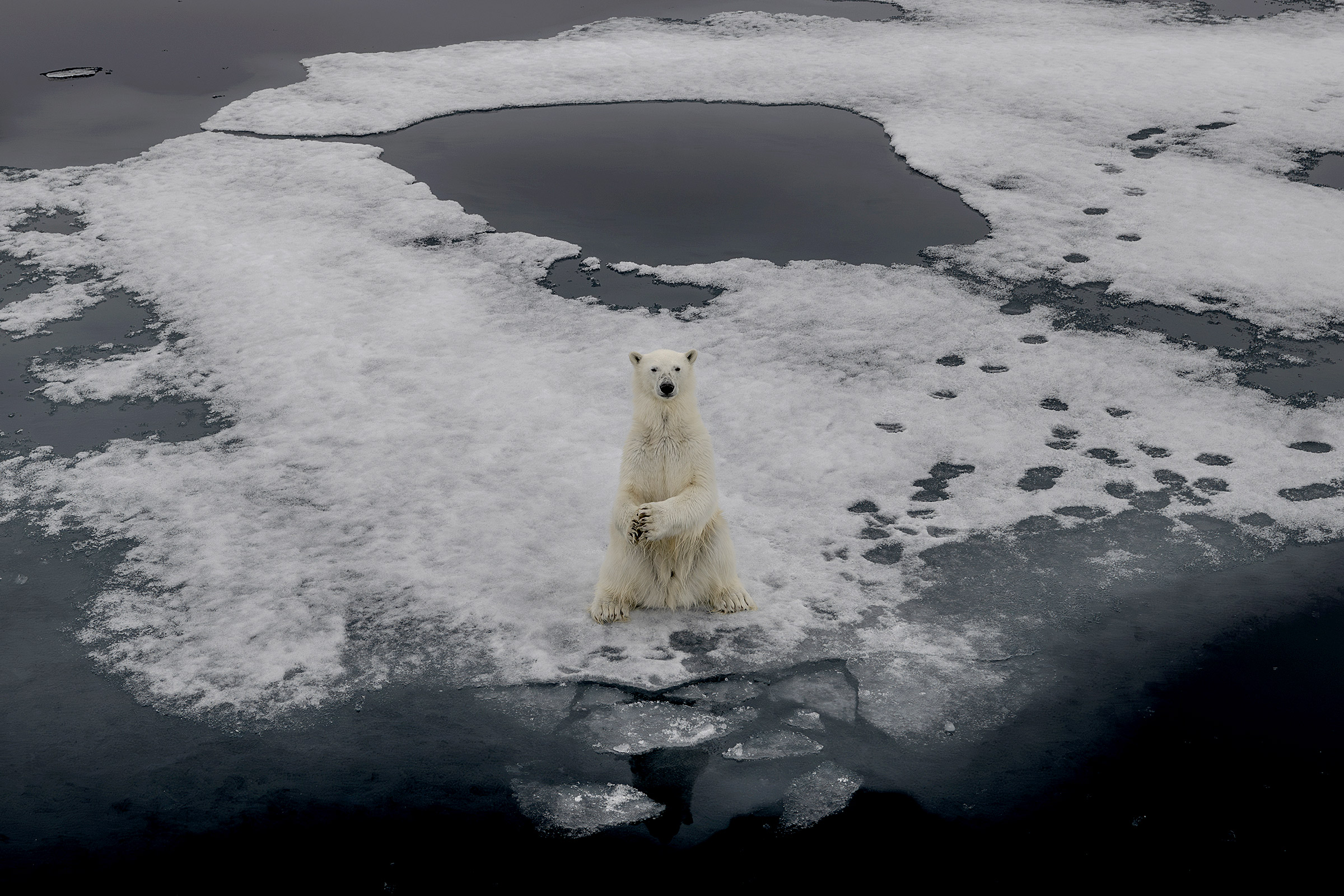It’s not easy to swim 175 km (109 mi.) when you’re starving to death. It’s not easy either to try to survive when you’re shedding body weight at a rate of 1 kg (2.2 lbs.) a day. And it might be hardest—or at least most tragic—of all if you’re a nursing mom and your calorie intake has dropped so low that you can no longer produce the milk you need to care for your young. As a new paper in Nature Communications reveals, all of those challenges and more are facing the world’s polar bears, thanks to vanishing sea ice in our warming world, denying the animals a platform that they need to hunt for seals. If the trend isn’t reversed soon, the estimated 26,000 polar bears in the wild could start to lose their hold on survival before the middle of this century.
The researchers were less interested in establishing the fact of the bears’ food plight; scientists are already aware of that problem. What they were more focused on learning was both how gravely the nutritional loss is affecting the animals’ health and the alternative food sources they’re scrounging for on land. To do their work, the scientists followed 20 different polar bears in Manitoba, Canada, from 2019 to 2022, fitting them with GPS trackers and video collars and periodically tranquilizing them and analyzing their blood, body mass, daily energy expenditure—basically a measure of calories coming in versus calories going out—and more.

“The polar bears in Hudson Bay [Canada] are probably at the edge of the range at which they can survive right now,” says Anthony Pagano, a research biologist with the U.S. Geological Survey and the lead author of the paper. “Most of the modeling work suggests that around 2050, they are going to be on land and away from their primary habitat [on the ice].” The contraction in range of the Hudson Bay community is likely to be reflected in the ranges of the 18 other polar bear subpopulations scattered throughout the Arctic as well.
Read more: The Arctic is Heating Up, Disrupting the Planet and Local Communities
Across the arc of the study, the data Pagano and his colleagues gathered was troubling. Weight loss varied from bear to bear, with the daily loss of 1 kg representing just an average; some of the subject animals dropped up to 1.7 kg (3.75 lbs) every 24 hours. That may not seem like much when an adult male polar bear can tip the scales at 550 kg (1,200 lbs) and a female at 320 kg (700 lbs), but it can add up fast. And with less available to eat, the hungry bears have to travel farther and farther distances to find their next meal. The individual that swam 175 km—a young female—set the record among the bears studied, but another, older female also covered 120 km (75 mi). The endurance swims in search of food are energy-intensive and often fruitless for the bears. They are efficient hunters when they’ve got the purchase of ice beneath them, Pagano and his colleagues explain, but they are clumsy when they are going after seals and trying to swim at the same time.

That leaves them scavenging on land for foods they would not ordinarily eat—and getting little payoff for their efforts. “Polar bears are feeding on ducks and geese—catching them when they’re flightless and molting—as well as on their eggs,” Pagano says. Other foods on the desperate bears’ menus included berries and other vegetation, bones, antlers and, in one case, a beluga whale carcass. None of that fare is as calorie-rich as a steady diet of live, blubber-packed seals. Some of the bears vigorously sought out these alternative sources of nutrition; others opted for a different strategy: resting and conserving the energy contained in their body mass. The latter approach costs stored calories, but so does the former, as all of the plodding and searching burns through energy too.
“The amount of body tissue they were burning to try and find those terrestrial foods was basically the same as what they’d get from eating those terrestrial foods,” Pagano says. “So there’s no actual benefit.”
The researchers were surprised to find that the bears were going through not just fat stores to compensate for the poor rations, but lean muscle tissue too. Pagano is not certain why their metabolisms would adopt that strategy, but he has some ideas. “There's some thought that burning lean body mass might be more energetically efficient in some respects relative to burning body fats,” he says. “Also, conserving their body fat might provide them better thermal regulation once the winter and the ice return.”
Read more: After Visiting Both Ends of the Earth, I Realized How Much Trouble We’re In
That seasonal freeze-over is shorter than it used to be—though not by a lot. In the 1980s, polar bears were on land for about 110 days out of the year, with no need to eat terrestrial foods since the fat deposits they’d accumulate thanks to wintertime seal-hunting was enough to carry them the rest of the year. Now they're off the ice for 130 days on average. It’s a measure of the nutritional knife’s-edge on which the bears operate that just 20 days can make the difference between whether they live and thrive or starve and die.
The individuals most likely to perish when food supplies are poor are young adults—due to their less-developed hunting skills—and cubs, whose principal source of nutrition, their mother’s milk, can vanish in lean times. “If females are fasting for extended periods, they will actually stop lactating,” says Pagano.

Full-grown bears are by no means immune to danger, however. The authors cite earlier research predicting that the adult male population could decrease by 24% if the ice-free summer season increases to 180 days. This is especially so given the enormous energy intake—about 22,500 calories per day—that the big males need to maintain their body weight.
Polar bears aren’t the only species menaced by these findings. Humans are in harm’s way too. The more time bears spend off the ice and on land, the greater the likelihood they will wander into cities and towns in search of something to eat—and residents could easily be hurt or attacked if they get in the way of the hungry animals. People might also even be seen as sources of prey.
“When polar bears are on land, they act like other bears and become omnivores,” says Pagano. “It does raise the potential for human-bear interactions.”
More Must-Reads from TIME
- Cybersecurity Experts Are Sounding the Alarm on DOGE
- Meet the 2025 Women of the Year
- The Harsh Truth About Disability Inclusion
- Why Do More Young Adults Have Cancer?
- Colman Domingo Leads With Radical Love
- How to Get Better at Doing Things Alone
- Michelle Zauner Stares Down the Darkness
Write to Jeffrey Kluger at jeffrey.kluger@time.com
